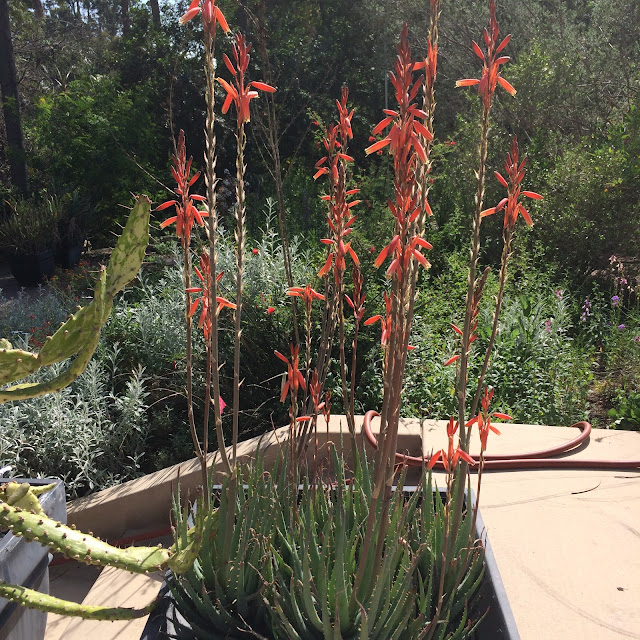It is gratifying for me to tell you about easy, long-blooming, and low-maintenance plants. Look at it this way, I grow all of the plants, so you don't have to! In my writing, I talk about the exemplary plants to grow in San Diego. If you share my love for colorful long-blooming plants that attract pollinators, I will give you my best plants. For the last two years, I have grown two Salvias from the four that make up the "Wendy" series. These are great plants as they are almost never out of bloom in my Zone 10 garden, and they are easy to take care of and maintain. Hummingbirds relish the large brightly-colored flowers, and can be found chasing each other to be the first to sip from these plants. Any one or all four of these will add bright hot tones to your garden color scheme.
 |
| Salvia x 'Wendy's Wish' S. Reeve |
'Wendy's Wish' is the name of a chance salvia seedling found in Wendy Smith's garden in Victoria, Australia. The plant she found wasn't like the rest of her salvias, and she isn't sure what combination of salvia species produced this outstanding hybrid. The flowers on this compact plant are large and magenta, like the flowers of Salvia buchananii but on a much smaller plant. As luck would have it she was able to patent it, and arranged to have a portion of the proceeds go to Make-a-Wish Australia.
From this original plant, three other selections were made: 'Ember's Wish' with coral-red flowers, 'Love and Wishes' with reddish-purple flowers, and 'Kisses and Wishes' with pink flowers. They all have the compact habit and large flower size of Salvia x 'Wendy's Wish.' The large tubular flowers are all rather fuzzy with dramatic calyxes as well. While the calyxes of 'Wendy's Wish' and a darker tint of magenta, the calyxes of 'Ember's Wish' are variable and range from reddish to very much greenish.
The literature says these Salvias will reach three feet tall and wide. This could be true, but I usually cut them back at the beginning of spring for dense growth and a bunch of new flowers, so they are staying around 2' x 2'. Even though this is considered "woody" salvia, I have had no trouble with cutting back into woody stems and getting regrowth. This is sometimes a problem for woody salvias, particularly native woody salvias like Cleveland sage.
Salvia x 'Ember's Wish' S. ReeveThese salvias do like water. They will reward regular and ample water with more blooming stems. They do not necessarily die when given less water, but they will be sparse and waiting for water when it comes. Well-drained fertile soil is best. Here in East County, a little shade is a good thing in the summer. Unlike most Salvias, a little shade does not slow flowering at all and the plant looks less stressed. They are hardy to Zone 8-9. What is lovely and appreciated is the plants do not require deadheading, the flowers drop off by themselves, and maintain their color the whole time on the plant. No ugly brown flowers to deal with. The colored calyxes look a bit like flowers and prolong the bloom time. The foliage is medium glossy green with dark stems. As you can see in the photo above these salvias combine well with succulents, as well as other perennials.
If you love to watch pollinators plant these all around your patio and in your patio pots to have a nonstop show of hummingbirds duking it out.
 |
| Close-up of the fuzzy flowers and persistent calyxes of 'Wendy's Wish' S. Reeve |

































